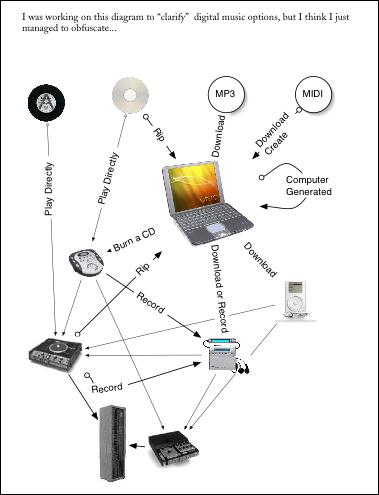| your computer (think player pianos and piano rolls). Thus, the sound quality is dependent both on the sequencer (the person who created the MIDI file) and on your sound card, just as how a piano roll sounds depends on the quality of the piano player who created the roll and on the player piano. There is a ton of free MIDI music on the web, but most of it is really bad. However, if you dig around, you might find some fun MIDI dance music. One more source is you. I know several GCA callers who have produced music | for themselves. There’s software out there that purports to allow even the most non-musical of us to make music. I don’t know about that, but if you have some skill, use it. With MP3 distribution, you could even sell it. (Be sure to check on licensing if the music isn’t your own composition.) Output First, all of these output devices need an amplifier and speakers. The Hilton systems that many of us use combine a turntable (for playing vinyl) and an amplifier. | Turntable: Plays vinyl records. Using records has three big advantages: ease of use, looping (record reset) and tempo control. The ease of use comes from the fact that each song is an individual unit, with lyrics attached (on the record jacket). Just grab it and throw it on the turntable. MiniDisc (MD) Player: Plays minidiscs (a small CD-like disk enclosed in a plastic case). Minidiscs are rugged and compact. Players range from extremely small to console models. New models (NetMD) allow rapid transfer of MP3 and sound files from a computer via a USB port. Ease of use: need to keep track of what song is on what disc and need some way of having lyrics. Looping: excellent--can achieve seamless loops by dividing patter records into three tracks and repeating the middle track. [2003: New models no longer have seamless looping; there’s a slight pause in the music as the loop resets.] Tempo control: Console models have good control. Newer portables have some, but it’s ineffective because it works in 5% increments. You can also have an external module installed on your portable (for a price, of course). CD Player: Plays CDs. You can get very inexpensive portable players. For more money, you can get players with tempo control. For even more money, you can get portable players with independent pitch and tempo controls. Organization: same issues as with minidisc, except you have more room to write on the CD. Looping: You can set a track to play repeatedly; the problem is that, unlike with minidiscs, you can’t set track marks on the CD. Some CDs from Square Tunes come with the patter music already divided into tracks, but this is no longer Square Tunes’ practice. (Given all the room available on CDs, you’d think producers could provide both the whole song and the song divided into three tracks.) You could also do track division on your computer before burning a CD. | |||||||||||
 | |||||||||||||
| Digital Music - CALLERLAB Presentation April 2003 | Page | 2 | |||||||||||